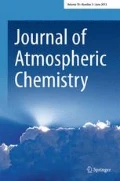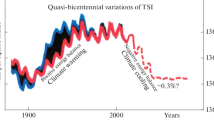Abstract
One-dimensional radiative-convective and photochemical models are used to examine the effects of enhanced CO2 concentrations on the surface temperature of the early Earth and the composition of the prebiotic atmosphere. Carbon dioxide concentrations of the order of 100–1000 times the present level are required to compensate for an expected solar luminosity decrease of 25–30%, if CO2 and H2O were the only greenhouse gases present. The primitive stratosphere was cold and dry, with a maximum H2O volume mixing ratio of 10−6. The atmospheric oxidation state was controlled by the balance between volcanic emission of reduced gases, photo-stimulated oxidation of dissolved Fe+2 in the oceans, escape of hydrogen to space, and rainout of H2O2 and H2CO. At high CO2 levels, production of hydrogen owing to rainout of H2O2 would have kept the H2 mixing ratio above 2×10−4 and the ground-level O2 mixing ratio below 10−11, even if no other sources of hydrogen were present. Increased solar UV fluxes could have led to small changes in the ground-level mixing ratios of both O2 and H2.
Similar content being viewed by others
References
Augustsson, T. and Ramanathan, V., 1977, A radiative-convective model study of the CO2 climate problem,J. Atmos. Sci. 34, 448–451.
Bar-Nun, A. and Chang, S., 1983, Photochemical reactions of carbon monoxide and water in Earth's primitive atmosphere,J. Geophys. Res. 88, 6662–6672.
Bevington, P. R., 1969,Data Reduction and Error Analysis for the Physical Sciences, McGraw-Hill, New York.
Borucki, W. J., 1983, Energy dissipation rate of terrestrial lightning, manuscript in preparation.
Braterman, P. S., Cairns-Smith, A. G., and Sloper, R. W., 1983, Photooxidation of hydrated Fe+2 — significance for banded iron formations,Nature 303, 163–164.
Burch, D. E., Gryvnak, D., Singleton, E. B., France, W. L., and Williams, D., 1962, Infrared Absorption by Carbon Dioxide, Water Vapor, and Minor Atmospheric Constituents, AFCRL-62-698.
Canuto, V. M., Levine, J. S., Augustsson, T. R., and Imhoff, C. L., 1982, UV radiation from the young sun and oxygen and ozone levels in the prebiological paleoatmosphere,Nature 296, 816–820.
Canuto, V. M., Levine, J. S., Augustsson, T. R., Imhoff, C. L., and Giampapa, M. S., 1983, The young Sun and the atmosphere and photochemistry of the early Earth,Nature 305, 281–286.
Carver, J. H., 1981, Prebiotic atmospheric oxygen levels,Nature 292, 136–138.
Cess, R. D. and Tiwari, S. N., 1972, Infrared radiative energy transfer in gases,Adv. Heat Transfer 8, 229–283.
Cloud, P. E., 1972, A working model of the primitive earth,Amer. J. Science 272, 537–548.
Cloud, P. E., 1973, Paleoecological significance of the banded iron formation,Econ. Geol. 68, 1135–1143.
Dawson, G. L., 1980, Nitrogen fixation by lightning,J. Atmos. Sci. 37, 174–178.
Fels, S. B., 1979, Simple strategies for inclusion of Voigt effects in infrared cooling rate calculations,Appl. Opt. 18, 2634–2637.
Fels, S. B. and Schwarzkopf, M. D., 1980, An efficient, accurate algorithm for calculating CO2 15-μm band cooling rates,J. Geophys. Res. 86, 1205–1232.
Fishman, J. and Crutzen, P. 1977, A numerical study of tropospheric photochemistry using a one-dimensional model,J. Geophys. Res. 82, 5897–5906.
Garrels, R. M. and Mackenzie, F. T., 1971,Evolution of Sedimentary Rocks, Norton, New York.
Garrels, R. M. and Perry, E. A., 1974, Cycling of carbon, sulfur, and oxygen through geologic time,The Sea 5, 303–336.
Goldman, A. and Kyle, T. G., 1968, A comparison between statistical model and line calculation with application to the 9.6 μm ozone and the 2.7 μm water vapor bands,Appl. Opt. 7, 1167–1177.
Gough, D. O., 1981, Solar interior structure and luminosity variations,Solar Phys.,74, 21–34.
Hart, M. H., 1978, The evolution of the atmosphere of the earth,Icarus 33, 23–39.
Henderson-Sellers, A., 1979, Clouds and the long-term stability of the earth's atmosphere and climate,Nature 279, 786–788.
Hill, R. D., Rinker, R. G., and Wilson, H. D., 1980, Atmospheric nitrogen fixation by lightning,J. Atmos. Sci. 37, 179–192.
Ho, W., Birnbaum, G., and Rosenberg, A., 1971, Far-infrared collision induced absorption in CO2. I. Temperature dependence,J. Chem. Phys. 55, 1028–1038.
Holland, H. D., 1973, The oceans: A possible source of iron in iron formations,Econ. Geol. 68, 1169–1172.
Howard, J. N., Burch, D. L., and William, D., 1956, Near-infrared transmission through synthetic atmospheres,J. Opt. Soc. Am. 46, 186–190.
Hummel, J. R. and Kuhn, W. R., 1981, Comparison of radiative-convective models with constant and pressure dependent lapse rates,Tellus 33, 254–261.
Ingersoll, A. P., 1969, The runaway greenhouse: A history of water on Venus,J. Atmos. Sci. 26, 1191–1198.
Kasting, J. F., 1979, Evolution of oxygen and ozone in the Earth's atmosphere, PhD dissertation, University of Michigan, Ann Arbor, Mich.
Kasting, J. F., 1982, Stability of ammonia in the primitive terrestrial atmosphere,J. Geophys. Res. 87, 3091–3098.
Kasting, J. F., Liu, S. C., and Donahue, T. M., 1979, Oxygen levels in the prebiological atmosphere,J. Geophys. Res. 84, 3097–3107.
Kasting, J. F. and Donahue, T. M., 1980, Evolution of atmospheric ozone,J. Geophys. Res.,85, 3255–3263.
Kasting, J. F. and Walker, J. C. G., 1981, Limits on oxygen concentration in the prebiological atmosphere 3nd the rate of abiotic fixation of nitrogen,J. Geophys. Res. 86, 1147–1158.
Kasting, J. F., Zahnle, K. J., and Walker, J. C. G., 1983, Photochemistry of methane in the Earth's early atmosphere,Precambrian Res. 20, 121–148.
Kasting, J. F., Pollack, J. B., and Ackerman, T. P., 1984, Response of Earth's atmosphere to increases in solar flux and implications for loss of water from Venus,Icarus,57, 335–355.
Kuhn, W. R. and Atreya, S. K., 1979, Ammonia photolysis and the greenhouse effect in the pirmordial atmosphere of the earth,Icarus 37, 207–213.
Kuhn, W. R. and Kasting, J. F., 1983. The effects of increased CO2 concentrations on surface temperature of the early earth,Nature 301, 53–55.
Lindzen, R. S. and Will, D. I., 1973, An analytic formula for heating due to ozone absorption,J. Atmos. Sci. 30, 513–515.
Lindzen, R. S., Hou, A. Y., and Farrell, B. F., 1982, The role of convective model choice in calculating the climate impact of doubling CO2,J. Atmos. Sci. 39, 1189–1205.
Lovelock, J. E. and Watson, A. J., 1982, The regulation of carbon dioxide and climate: Gaia or geochemistry,Planet. Space Sci. 30, 795–802.
Lovelock, J. E. and Whitfield, M., 1982, Life span of the biosphere,Nature 296, 561–563.
Malkmus, W., 1967, Random Lorentz band model with exponential-tailed S−1 line intensity distribution function,J. Opt. Soc. Am. 57, 323–329.
Manabe, S. and Wetherald, R. T., 1967, Thermal equilibrium of the atmosphere with a given distribution of relative humidity,J. Atmos. Sci. 24, 241–259.
Mastenbrook, H. J., 1968, Water vapor distribution in the stratosphere and high troposphere,J. Atmos. Sci. 25, 299–311.
Moore, J. F., 1971, Infrared absorption of carbon dioxide at high densities with application to the atmosphere of Venus, Rep. X-630–72–48, NASA Goddard Space Flight Center, Greenbelt, Maryland.
Mount, G. H., Rottman, G. J., and Timothy, J. G., 1980, The solar spectral irradiance 1200–2550 Å at solar maximum,J. Geophys. Res. 85, 4271–4274.
Newman, M. J. and Rood, R. T., 1977, Implications of solar evolution for the earth's early atmosphere,Science 198, 1035–1037.
North, G. R., 1975, Theory of energy-balance climate models,J. Atmos. Sci. 32, 2033–2043.
Owen, T., Cess, R. D., and Ramanathan, V., 1979, Early Earth: An enhanced carbon dioxide greenhouse to compensate for reduced solar luminosity,Nature 277, 640–642.
Pinto, J. P., Gladstone, C. R., and Yung, Y. L., 1980, Photochemical production of formaldehyde in the earth's primitive atmosphere,Science 210, 183–185.
Pollack, J. B., Toon, O. B., and Boese, R., 1980, Greenhouse models of Venus' high surface temperature, as constrained by Pioneer Venus measurements,J. Geophys. Res. 85, 8223–8231.
Ramanathan, V., 1976, Radiative transfer within the Earth's troposphere and stratosphere: A simplified radiative-convective model,J. Atmos. Sci. 33, 1330–1346.
Roberts, R. E., Selby, J. E. A., and Biberman, L. M., 1976, Infrared continuum absorption by atmospheric water vapor in the 8–12 μm window,Appl. Opt. 15, 2085–2090.
Rodgers, C. D. and Walshaw, C. D., 1966, The computation of infrared cooling rate in planetary atmospheres,Quart. J. Roy. Meteor. Soc. 92, 67–92.
Rossow, W. B., Henderson-Sellers, A., and Weinreich, S. K., 1982, Cloud feed-back: A stabilizing effect for the early earth?,Science 217, 1245–1247.
Sagan, C. and Mullen, G., 1972, Earth and Mars: Evolution of atmospheres and surface temperatures,Science 177, 52–56.
Schatten, K. H. and Endal, A. S., 1982, The faint young sun-climate paradox: Volcanic influences,Geophys. Res. Lett. 9, 1309–1311.
Thompson, B. A., Harteck, P., and Reeves, R. R. Jr., 1963, Ultraviolet absorption coefficients of CO2, CO, O2, H2O, N2O, NH3, NO, SO2, and CH4 between 1850 and 4000 Å,J. Geophys. Res. 68, 6431–6436.
Towe, K. M., 1981, Environmental conditions surrounding the origin and early Archean evolution of life: A hypothesis,Precambian Res. 16, 1–10.
Veizer, J., Compston, W., Hoefs, J. and Nielson, H., 1982, Mantle buffering of the early oceans,Naturwissenschaften 69, 173–180.
Visconti, G., 1982, Radiative-photochemical models of the primitive terrestrial atmosphere,Planet. Space Sci. 30, 785–793.
Walker, J. C. G., 1976, Implications for atmospheric evolution of the inhomogeneous accretion model of the origin of the Earth, in B. F.Windley (ed.),The Early History of the Earth, Wiley, New York, pp. 537–546.
Walker, James C. G., 1977,Evolution of the Atmosphere, MacMillan, New York.
Walker, J. C. G., 1982, Climatic factors on the Archean earth,Pageoph. 40, 1–11.
Walker, J. C. G., 1983, Possible limits on the composition of the Archean ocean,Nature 302, 518–520.
Walker, J. C. G., P. B.Hays, and J. F.Kasting, 1981, A negative feedback mechanism for the long-term stabilization of Earth's surface temperature,J. Geophys. Res. 86, 9776–9782.
Wang, W. C. and P. H.Stone, 1980, Effect of ice-albedo feedback on global sensitivity in a one-dimensional radiative-convective climate model,J. Atmos. Sci. 37, 545–552.
Yung, Y. L., 1976, A numerical method for calculating the mean intensity in an inhomogeneous Rayleigh scattering atmosphere,J. Quant. Spectrosc. Radiat. Transfer 16, 755–761.
Yung, Y. L. and McElroy, M. B., 1979, Fixation of nitrogen in the prebiotic atmosphere,Science 203, 1002–1004.
Zahnle, K. J. and Walker, J. C. G., 1982, The evolution of solar ultraviolet luminosity,Rev. Geophys. Space Phys. 20, 280–292.
Author information
Authors and Affiliations
Rights and permissions
About this article
Cite this article
Kasting, J.F., Pollack, J.B. & Crisp, D. Effects of high CO2 levels on surface temperature and atmospheric oxidation state of the early Earth. J Atmos Chem 1, 403–428 (1984). https://doi.org/10.1007/BF00053803
Received:
Revised:
Issue Date:
DOI: https://doi.org/10.1007/BF00053803




